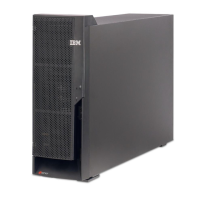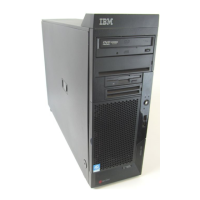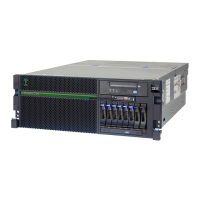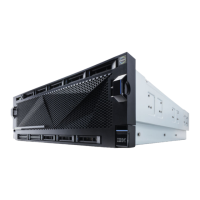Towers, racks, and high-speed link 293
Draft Document for Review October 18, 2004 5486Towr.fm
High-speed link
HSL fabric
HSL loops provide redundancy to all attached towers. In addition, the
implementation of HSL and OS/400 provide data flow balancing across the loop
by assigning communication paths during an initial program load (IPL) to
optimize loop throughput based upon loop and tower configurations.
HSL loops can be either copper or optical. Optical provides longer distance, but
offers a lower data rate.
With iSeries Models 825, 870, and 890, and with I/O towers, such as the
#5094 PCI-X Expansion Tower, #0595/#5095 PCI-X Expansion Tower, and
#0588/#5088 PCI-X Expansion Unit, a slightly different copper HSL port is
used—HSL-2.
There is no change to the optical HSL loop on Models 825, 870, and 890.
Considerations for loop configurations include:
Rack mounted Model 520 system units can only attach to HSL-2/RIO-G
cables 2.5m or longer and can only attach to SPCN cables 3m or longer.
Shorter cable lengths do not allow the system unit to be pulled out from the
rack far enough for concurrent maintenance.
iSeries Models 825, 870, 890 with V5R2 or V5R3 do not support
HSL-2/RIO-G even with RIO-G nodes attached. A link between two RIO-G
nodes runs at HSL-2/RIO-G speed only.
The speed allowed by the two nodes of a link with Eserver i5 servers
attached are:
– 1 GB/sec for RIO-G to RIO-G
– 500 MB/sec for RIO to RIO-G
Due to the high bandwidth of HSL, you should see comparable performance,
whether using copper or optical HSL, even though optical runs at a slower speed.
However, if you have intensive I/O bandwidth requirements (for example, large
system data mining), you may experience some performance degradation with
optical HSL. The recommendation is to use less than the allowed maximum
number of I/O towers on an optical fiber HSL loop to optimize performance.
HSL was initially implemented at OS/400 V5R1 using copper interconnect
cables. These cables allow for high-speed and high-quality parallel data transfer.
In August 2001, technology was introduced using optical fibres and optical
adapters to interconnect the Central Electronic Complex (CEC) and the towers of
the iSeries server.
